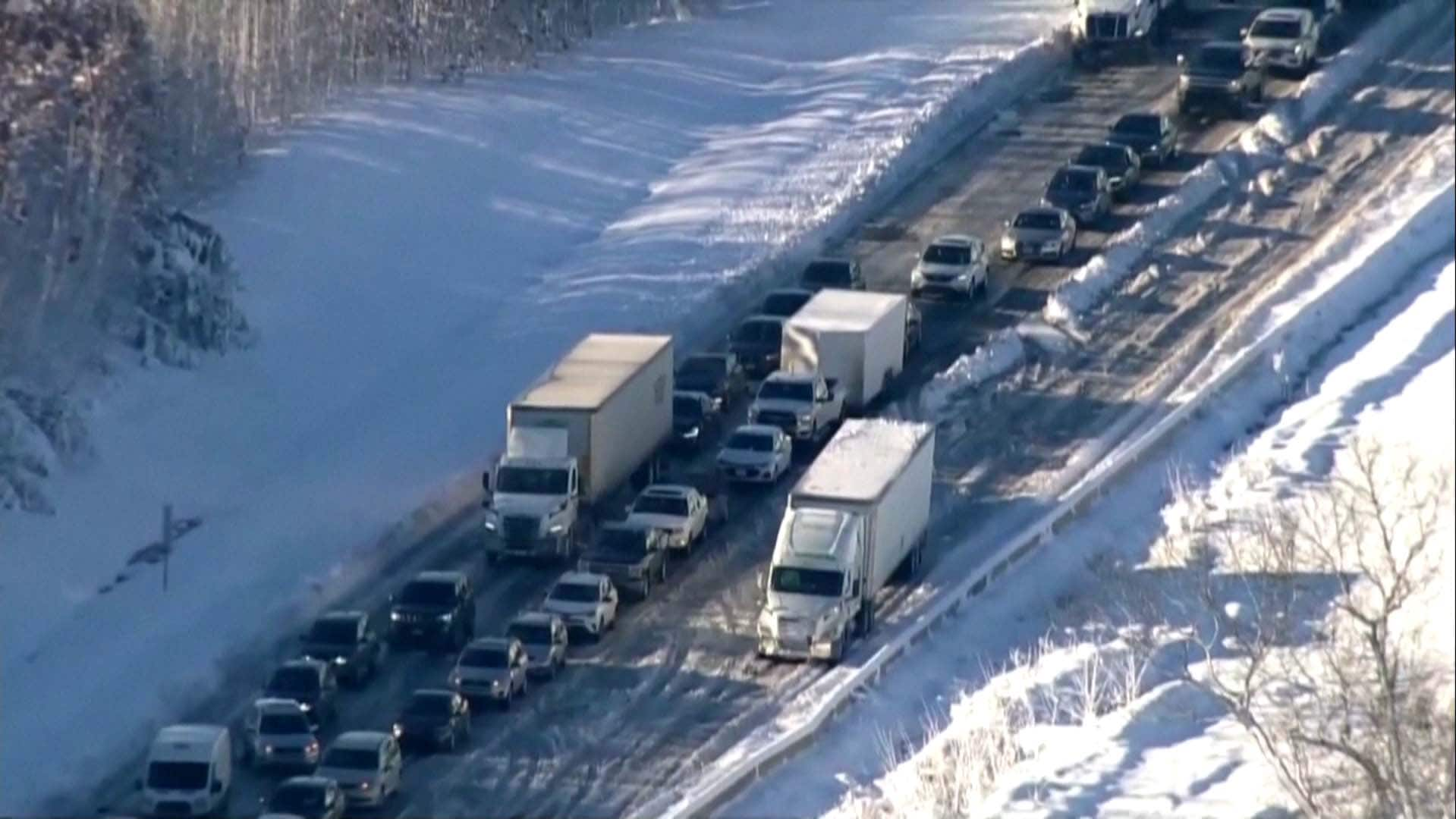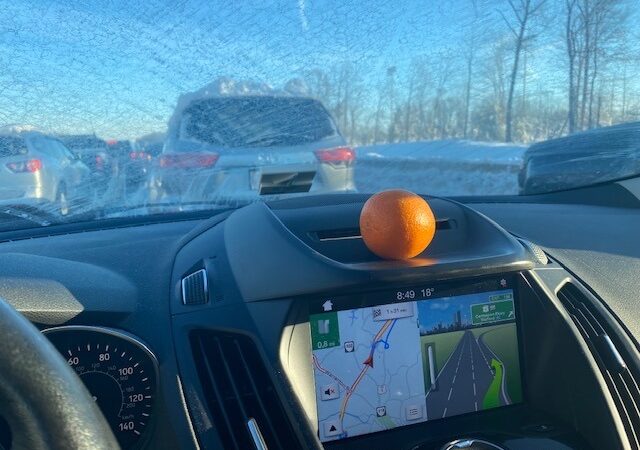Motorists posted messages on social media about running out of fuel, food and water

Winter storm strands hundreds of Virginia motorists
14 hours agoDuration 2:00Hundreds of drivers along Interstate 95 in Virginia were stranded after a major winter storm blanketed the U.S. east coast. 2:00
The last motorists out of hundreds who were stranded on a highway in Virginia — some for almost a day — by a winter storm have been cleared, officials said early Tuesday evening.
The storm snarled traffic and left some drivers stuck for nearly 24 hours in freezing temperatures along an impassable stretch of highway south of Washington.
Problems began Monday morning when a truck jackknifed on Interstate 95, the main north-south highway along the East Coast, triggering a swift chain reaction as other vehicles lost control, state police said. Lanes in both directions became blocked across a 65-kilometre stretch of I-95 north of Richmond, Va.
As hours passed and night fell, motorists posted messages on social media about running out of fuel, food and water.
Meera Rao and her husband, Raghavendra, were driving home from visiting their daughter in North Carolina when they got stuck Monday evening. They were only 30 metres past an exit but could not move for roughly 16 hours.
“Not one police [officer] came in the 16 hours we were stuck,” she said. “No one came. It was just shocking. Being in the most advanced country in the world, no one knew how to even clear one lane for all of us to get out of that mess?”
There were no immediate reports of serious injuries or deaths.

Around daybreak, road crews began helping drivers get off “at any available interchange,” the Virginia Department of Transportation tweeted.
By early evening, only about 20 cars remained on the affected section of road and no one was left stranded, a department spokesperson said.
Some motorists on the highway may still be in the process of being routed around closures, the agency said.
An Associated Press photographer who flew in a helicopter along an 80-kilometre stretch of highway observed about a dozen clusters of stuck vehicles on Tuesday afternoon.
Crews were trying to first clear vehicles that could move on their own. Then they would tow disabled or abandoned ones and plow, said Marcie Parker, a Virginia Department of Transportation engineer leading the effort. She expected the roadway to be cleared for the Wednesday morning rush hour.
People could be seen walking down traffic lanes that were still covered with ice and snow.
Criticism over state’s response
Gov. Ralph Northam said his team responded through the night, sending out emergency messages to connect drivers with help and working with local officials to set up warming shelters as needed. Officials told reporters crews were helping distribute food, water and fuel.
People who were stranded overnight and their families lashed out at Northam on Twitter, asking why the National Guard was not deployed.
Northam said in an interview he opted not to request National Guard help because the issue facing state crews was not a lack of manpower but the difficulty of getting workers and equipment through the snow and ice to where they needed to be. He said that effort was complicated by disabled vehicles, freezing temperatures and ice.
The affected section of highway was not pretreated, Parker said, because heavy rain preceded the snow, which fell as heavily as five centimetres an hour at times.
“That was entirely too much for us to keep up with,” she said.

The storm also left passengers on an Amtrak train stranded in Virginia. Amtrak’s Crescent left New Orleans on Sunday on its way to New York and got stuck near Lynchburg on Monday morning, when downed trees blocked the tracks.
Passenger Sean Thornton told AP that Amtrak provided food, but toilets were overflowing and passengers were furious. Amtrak planned for the train to complete its trip once the tracks are clear.
Back on the highway, Rao said they stopped their car engine at least 30 times to conserve gas and ran the heat just enough to get warm. They had some potato chips, nuts and apples to eat, but Rao did not want to drink any bottled water because she had a sprained ankle and did not think she could reach a makeshift restroom.
Finally, around midmorning Tuesday, a tow-truck driver appeared and cleared away snow, allowing the Raos and other cars to back up and take the exit.
“He was a messenger from God,” Rao said. “I literally was in tears.”
Senator among those stranded
Up to 28 centimetres of snow fell in the area during Monday’s storm, according to the National Weather Service, and state police had warned people to avoid driving unless absolutely necessary.
Compounding the challenges, traffic cameras went offline as much of central Virginia lost power in the storm, the transportation department said.

Sen. Tim Kaine, who lives in Richmond, told WTOP Tuesday morning that he had been stuck in his car for 21 hours after starting his two-hour commute to the Capitol at 1 p.m. Monday.
“This has been a miserable experience,” Kaine said. Traffic was so tightly packed that emergency vehicles struggled to remove disabled cars and trucks, he said.
Kaine described camaraderie among those who were stranded, including a Connecticut family returning from a Florida vacation who walked up and down lines of parked cars sharing a bag of oranges.
Late Tuesday afternoon, he tweeted that he had finally made it to the Capitol “after 27 hours on the road.”
Darryl Walter, of Bethesda, Md., was stuck for 10 hours as he drove home from a Florida beach vacation with his wife, son and dog, Brisket.
They had a few bottles of water, some bags of chips, a blanket for warmth and Trivial Pursuit to pass the time. Walter said the worst part of the ordeal was not knowing how long it would last.
Walter said he felt fortunate that they were able to make it home as soon as they did knowing that many others remained stranded for much longer. They passed a long line of southbound cars that were unable to get past the jackknifed trucks.
“It had to be 15 miles of backup,” he said.
‘Always pack a Snickers bar’
A planned one-hour drive home from her parents’ house turned into a 16-hour nightmare for Susan Phelan when she got stuck in the northbound lanes of I-95 and did not move for roughly 10 hours.
After a frigid night without sleep, food or water, she pulled into the driveway at her Alexandria, Va., home just before noon Tuesday.
“Mom was right: Always pack a Snickers bar,” said Phelan, a former federal communications officer.
“At some point in the gridlock, I was going to have to start knocking on windows asking for water. At that point, everybody was helping everybody. If you needed something, it was not a problem.”

Also stranded was NBC News correspondent Josh Lederman, who spoke on NBC’s Today show on Tuesday via video feed from his car. He said he had been stuck about 50 kilometres south of Washington since 8 p.m. Monday.
In Prince William County, Va., emergency crews responded Tuesday to 10 calls from motorists, including complaints about hypothermia and diabetics concerned about a prolonged lack of food, said Matt Smolsky, assistant fire chief. None of the calls were life-threatening, but four patients were transported.
Crews used the express lanes that separate the northbound and southbound lanes to reach patients, he said.
Parker said the position of the traffic backups in relation to the express lanes meant they were not of much use to clear the logjams.


